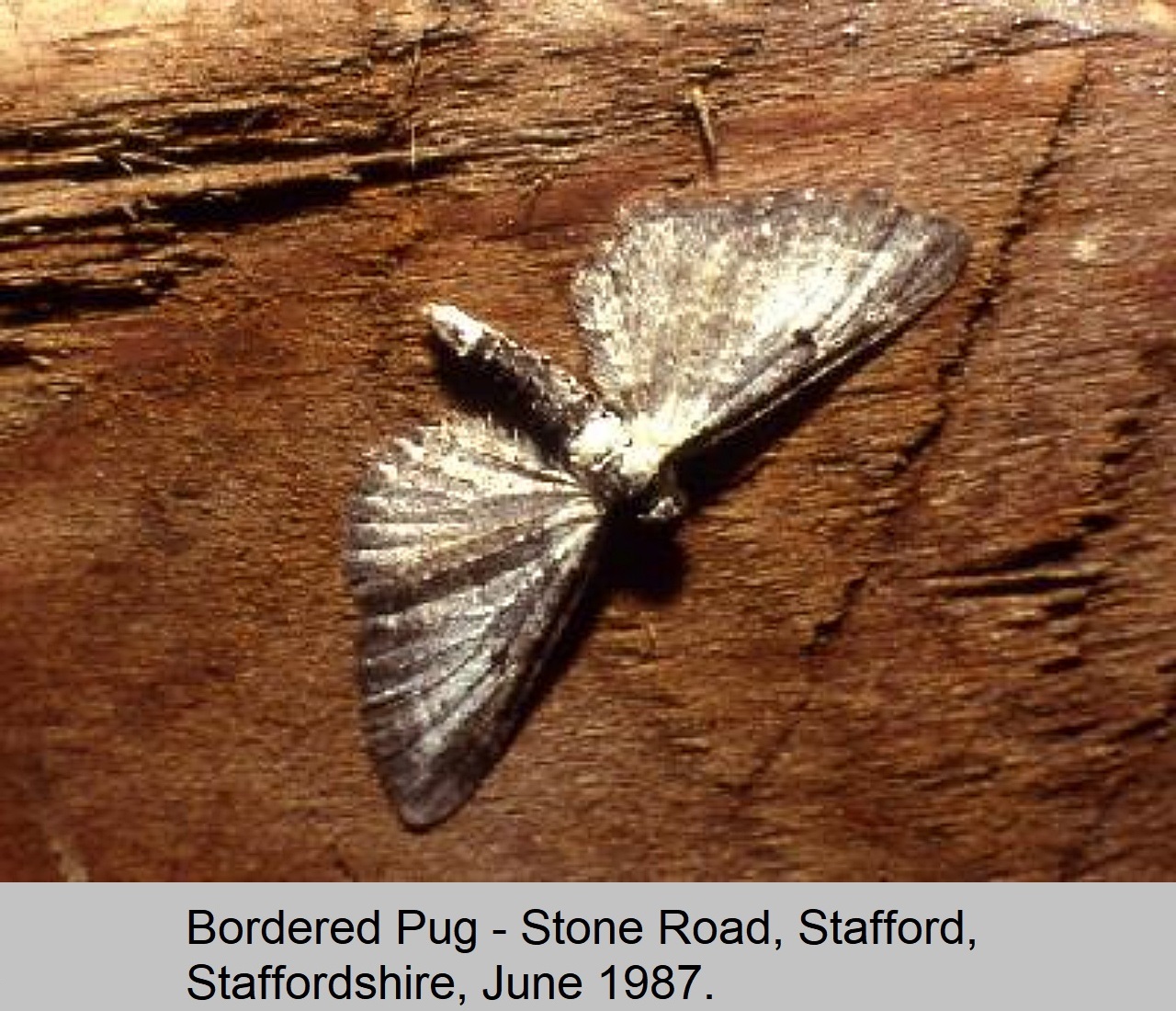|
|
||||||
|
|
|
|||||
| (Haworth 1809) | (Haworth 1809) | (Hubner 1809 to 1813) | (Hubner 1809 to 1813) | |
| Geometridae - Larentiinae | Geometridae - Larentiinae | Geometridae - Larentiinae | Geometridae - Larentiinae | |
| Common Pug | Common Pug | Mottled Pug | Mottled Pug | |
| Eupithecia vulgata | Eupithecia vulgata | Eupithecia exiguata exiguata | Eupithecia exiguata exiguata | |
| 70.183 BF 1834 | 70.183 BF 1834 | 70.184 BF 1819 | 70.184 BF 1819 | |
 |
Status: Resident in UK. Wing Span: 18mm to 21mm. Flight Period: May and June, again in August. Habitat: Found in parks, gardens, woods, disused railways, heaths, commons, and where the larval food plants grow. Comment: This moth is widely throughout much of the UK, including the Inner Hebrides and Ireland. |
|
Status: Resident in UK. Wing Span: 20mm to 22mm. Flight Period: May and June. Habitat: They inhabit bushy area's, the larvae feed on a variety of tree's and shrubs. Comment: This moth is widely distributed through out England, Wales and Ireland. In Scotland it is very local and scarce. |
Spare slot for expansion |
| (Linnaeus 1758) | (Linnaeus 1758) | (Denis & Schiffermuller 1775) | (Denis & Schiffermuller 1775) | |
| Geometridae - Larentiinae | Geometridae - Larentiinae | Geometridae - Larentiinae | Geometridae - Larentiinae | |
| Bordered Pug | Bordered Pug | Shaded Pug | Shaded Pug | |
| Eupithecia succenturiata | Eupithecia succenturiata | Eupithecia subumbrata | Eupithecia subumbrata | |
| 70.188 BF 1839 | 70.188 BF 1839 | 70.189 BF 1840 | 70.189 BF 1840 | |
 |
Status: Resident in UK. Wing Span: 21mm to 24mm. Flight Period: July and August. Habitat: Found on commons, waste ground, road side verges and other places where Mugwort grows. Comment: This moth is common and wide spread in the south of England. It scarcer in the rest of England, and local in Wales, Scotland and Ireland. |
|
Status: Resident in UK. Wing Span: 16mm to 20mm. Flight Period: June and July. Habitat: Found on grasslands, salt marshes and sea cliffs with Field Scabious and St Johns-wort grow. Comment: This moth is locally common, in south and east England. In the rest of Britain it is scarce and local, found as far north as Yorkshire and Lancashire. |
Spare slot for expansion
|
| Haworth 1809) | Haworth 1809) | Haworth 1809) | ||
| Geometridae - Larentiinae | Geometridae - Larentiinae | Geometridae - Larentiinae | ||
| Grey Pug | Grey Pug | Grey Pug | ||
| Eupithecia subfuscata | Eupithecia subfuscata | Eupithecia subfuscata | ||
| 70.190 BF 1837 | 70.190 BF 1837 | 70.190 BF 1837 | ||
|
|
 |
Status: Resident in UK. Wing Span: 17mm to 21mm. Flight Period: July and August. Habitat: To be found in parks, gardens, woodland rides and fringes, hedgerows, waste ground, and where ever the food plants grow. Comment: This moth is fairly common, and widely distributed throughout most of the British Isles. There is a melanic form of this moth. |
Spare slot for expansion |
Next Geometridae -Ennominae Species 70.205 to 70.237 continued on the next page |
| (Linnaeus 1758) | (Linnaeus 1758) | (Hufnagel 1767) | (Hufnagel 1767) | |
| Geometridae - Larentiinae | Geometridae - Larentiinae | Geometridae - Larentiinae | Geometridae - Larentiinae | |
| The Treble-bar | The Treble-bar | The Seraphim | The Seraphim | |
| Aplocera plagiata plagiata | Aplocera plagiata plagiata | Lobophora halterata | Lobophora halterata | |
| 70.192 BF 1867 | 70.192 BF 1867 | 70.198 BF 1879 | 70.198 BF 1879 | |
|
|
Status: Resident in UK. Wing Span: 37mm to 43mm. Flight Period: May and June, again in August and September in the south. Habitat: They inhabit down land, moor land, wood land and some times the fringes of marshy area's and park land, where St Johns-wort grows. Comment: Fairly common over most of Britain. |
 |
Status: Resident in UK. Wing Span: 29mm to 32mm. Flight Period: May and June. Habitat: Found in a variety of locations with mature Poplar and Aspen tree's. Comment: Moths of this species are well established in southern England and Wales, Ireland and southern Scotland. In the rest of Britain it is sparsely distributed. |
Bumps, Humps and Knobs The next group of moths have some very similar species, and both the adults and larvae vary widely in colouration. Most larvae have projections like bumps, filaments and warts. The placement and types of projections are unique to each species. So although the caterpillars can look very similar it is possible by carefully noting the arrangement of these features to identify the individual species. Further more some the female adults are wingless. |
|
Contact Website Manager dave.hatton29@btinternet.com |
Web Designer Dave Hatton |
Dave Hatton reserves the copyright on all images. © 2022 |
||||||